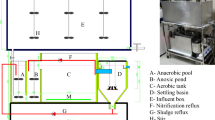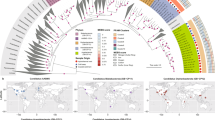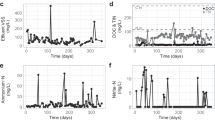Abstract
A fatal bulking phenomenon was found to occur occasionally in the methanogenic granular sludge of a mesophilic (35–40°C), full-scale upflow anaerobic sludge blanket (UASB) reactor treating organic wastewater discharged from a sugar manufacturing factory. A vast number of filamentous cells were observed in the bulking sludge that were morphologically distinct from the previously recognized anaerobic bulking agent Anaerolinea thermophila. 16S rRNA gene-based analyses of the microbial populations in the bulking sludge revealed that the dominant filamentous organisms were members of proposed candidate bacterial phylum, KSB3. Fluorescence in situ hybridization (FISH) analysis of the healthy sludge granules showed that the KSB3 filaments were the dominant granule surface population suggesting that they are fundamental constituents of the sludge granules and that they occasionally overgrow in the reactor, possibly triggering the filamentous bulking. We surveyed 10 additional mesophilic and thermophilic anaerobic sludges for the presence and diversity of KSB3 populations. Bacteria closely related to the characterized KSB3 filaments were present in two types of mesophilically grown UASB sludge granules treating actual wastewater discharged from sugar-processing industries.
Similar content being viewed by others
Log in or create a free account to read this content
Gain free access to this article, as well as selected content from this journal and more on nature.com
or
Accession codes
References
Alphenaar PA . (1994). Anaerobic granular sludge: characterization and factors its functioning. PhD dissertation, Wageningen Agricultural University, Wageningen, The Netherlands.
Amann RI, Binder BJ, Olson RJ, Chisholm SW, Devereux R, Stahl DA . (1990). Combination of 16S rRNA-targeted oligonucleotide probes with flow cytometry for analyzing mixed microbial populations. Appl Environ Microbiol 56: 1919–1925.
Angenent LT, Sung S . (2001). Development of anaerobic migrating blanket reactor (AMBR), a novel anaerobic treatment system. Wat Res 35: 1739–1747.
Björnsson L, Hugenholtz P, Tyson GW, Blackall LL . (2002). Filamentous Chloroflexi (green non-sulfur bacteria) are abundant in wastewater treatment processes with biological nutrient removal. Microbiology 148: 2309–2318.
Clesceri LS, Greenberg AE, Eaton AD . (1998). Standard Methods for the Examination of Water and Wastewater, 20th edn. APHA AWWA WEF: USA.
Daims H, Brühl A, Amann R, Schleifer K, Wagner M . (1999). The domain-specific probe EUB338 is insufficient for the detection of all Bacteria: development and evaluation of a more comprehensive probe set. System Appl Microbiol 22: 434–444.
Dojka MA, Harris JK, Pace NR . (2000). Expanding the known diversity and environmental distribution of an uncultured phylogenetic division of bacteria. Appl Environ Microbiol 66: 1617–1621.
Donlon B, Razo-Flores E, Luijten M, Swarts H, Lettinga G, Field J . (1997). Detoxification and partial mineralization of the azo dye mordant orange 1 in a continuous upflow anaerobic sludge-blanket reactor. Appl Environ Biotechnol 47: 83–90.
Endo G, Tohya Y . (1988). Ecological study on anaerobic sludge bulking caused by filamentous bacterial growth in anaerobic contact process. Wat Sci Tech 20: 205–211.
Felsenstein J . (1985). Confidence limits on phylogenies: an approach using the bootstrap. Evolution 39: 783–791.
Gich F, Garcia-Gil J, Overmann J . (2001). Previously unknown and phylogenetically diverse members of the green nonsulfur bacteria are indigeneous to freshwater lakes. Arch Microbiol 177: 1–10.
Guiot SR, Pauss A, Costerton JW . (1992). A structured model of the anaerobic granule consortium. Wat Sci Tech 25: 1–10.
Harmsen HJM, Kengen HMP, Akkermans ADL, Stams AJM, de Vos WM . (1996). Detection and localization of syntrophic propionate-oxidizing bacteria in granular sludge by in situ hybridization using 16S rRNA-based oligonucleotide probes. Appl Environ Microbiol 62: 1656–1663.
Hugenholtz P, Huber T . (2003). Chimeric 16S rDNA sequences of diverse origin are accumulating in the public databases. Int J Syst Evol Microbiol 53: 289–293.
Imachi H, Sekiguchi Y, Kamagata Y, Hanada S, Ohashi A, Harada H . (2002). Pelotomaculum thermopropionica gen. nov., sp. nov., an anaerobic, thermophilic, syntrophic propionate-oxidizing bacterium. Int J Syst Evol Microbiol 52: 1729–1735.
Jobb G . (2005). TREEFINDER version of June 2005. Munich, Germany. Distributed by the author at www.treefinder.de.
Kleerebenzem R, Macarie H . (2003). Treating industrial wastewater: Anaerobic digestion comes of age. Chem Eng April, 2003: 56–65.
Kosaric N, Blaszczyk R, Orphan L, Valladares J . (1990). The characteristics of granules from upflow anaerobic sludge blanket reactors. Water Res 24: 1473–1477.
Lepistš R, Rintala J . (1999). Extreme thermophilic (70°C), VFA-fed UASB reactor: performance, temperature response, load potential and comparison with 35 and 55 °C UASB reactors. Water Res 33: 3162–3170.
Lettinga G . (1995). Anaerobic digestion and wastewater treatment systems. Antonie van Leeuwenhoek 67: 3–28.
Lettinga G, Rebac S, Zeeman G . (2001). Challenge of psychrophilic anaerobic wastewater treatment. Trends in Biotechnol 19: 363–370.
Ley RE, Harris JK, Wilcox J, Spear JR, Miller SR, Bebout BM et al. (2006). Unexpected diversity and complexity of the Gurrero Negro Hypersaline Microbial Mat. Appl Environ Microbiol 72: 3685–3695.
Liu W-T, Chan O-C, Fang HHP . (2002). Characterization of microbial community in granular sludge treating brewery wastewater. Water Res 36: 1767–1775.
Lowry OH, Rosbrough NJ, Farr AL, Randall RJ . (1951). Protein measurement with folin phenol reagent. J Biol Chem 193: 265.
Ludwig W, Strunk O, Westram R, Richter L, Meier H, Yadhukumar et al. (2004). ARB: a software environment for sequence data. Nucleic Acids Res 32: 1363–1371.
Miller DN, Bryant JE, Madsen EL, Ghiorse WC . (1999). Evaluation and optimization of DNA extraction and purification procedures for soil and sediment samples. Appl Environ Microbiol 65: 4715–4724.
Rebac S, van Lier JB, Lens P, Stams AJM, Dekkers F, Swinkels KTM et al. (1999). Psychrophilic anaerobic treatment of low strength wastewaters. Water Sci Tech 39: 203–210.
Ronquist F, Huelsenbeck JP . (2003). MrBayes 3: Bayesian phylogenetic inference under mixed models. Bioinformatics 19: 1572–1574.
Saitou N, Nei M . (1987). The neighbor-joining method: A new method for reconstructing phylogenetic trees. Mol Biol Evol 4: 406–425.
Sekiguchi Y, Kamagata Y . (2004). Strict and facultative anaerobes: medical and environmental aspects. In: Nakano MM, Zuber P (eds). Microbial Community Structure and Functions in Methane Fermentation Technology for Wastewater Treatment. Horizon Bioscience: UK, pp 361–384.
Sekiguchi Y, Kamagata Y, Nakamura K, Ohashi A, Harada H . (1999). Fluorescence in situ hybridization using 16S rRNA-targeted oligonucleotides reveals localization of methanogens and selected uncultured bacteria in mesophilic and thermophilic sludge granules. Appl Environ Microbiol 65: 1280–1288.
Sekiguchi Y, Kamagata Y, Syutsubo K, Ohashi A, Harada H, Nakamura K . (1998). Phylogenetic diversity of mesophilic and thermophilic granular sludges determined by 16S rRNA gene analysis. Microbiology 144: 2655–2665.
Sekiguchi Y, Takahashi H, Kamagata Y, Ohashi A, Harada H . (2001). In situ detection, isolation, physiological properties of a thin filamentous microorganism abundant in methanogenic granular sludges: a novel isolate affiliated with a clone cluster, the green non-sulfur bacteria, subdivision I. Appl Environ Microbiol 67: 5740–5749.
Sekiguchi Y, Yamada T, Hanada S, Ohashi A, Harada H, Kamagata Y . (2003). Anaerolinea thermophila gen. nov., sp. nov. and Caldilinea aerophila gen. nov., sp. nov., novel filamentous thermophiles that represent a previously uncultured lineage of the domain Bacteria at the subphylum level. Int J Syst Evol Microbiol 53: 1843–1851.
Stahl DA, Flesher B, Mansfield HR, Montgomery L . (1988). Use of phylogenetically based hybridization probes for studies of ruminal microbial ecology. Appl Environ Microbiol 54: 1079–1084.
Swofford DL . (2002). PAUP*: Phylogenetic analysis using parsimony (* and other methods) version 4. Sinauer Associates: Sunderland, MA.
Tanner MA, Everett CL, Coleman WJ, Yang MM, Youvan DC . (2000). Complex microbial communities inhabiting sulfide-rich black mud from marine coastal environments. Biotechnology 8: 1–16.
Uemura S, Harada H . (1993). Microbial characteristics of methanogenic sludge consortia developed in thermophilic UASB reactors. Appl Microbiol Biotechnol 39: 654–660.
Uemura S, Harada H . (2000). Treatment of sewage by a UASB reactor under moderate to low temperature conditions. Biores Tech 72: 275–282.
Vallero MVG, Camarero E, Lettinga G, Lens PNL . (2004). Thermophilic (55–65°C) and extreme thermophilic (70–80°C) sulfate reduction in methanol and formate-fed UASB reactors. Biotechnol Prog 20: 1382–1392.
van der Zee FP, Lettinga G, Field JA . (2001). Azo dye decolourisation by anaerobic granular sludge. Chemosphere 44: 1169–1176.
Weisburg WG, Barns SM, Pelletier DA, Lane DJ . (1991). 16S ribosomal DNA amplification for phylogenetic study. J Bacteriol 173: 697–703.
Wu W-M, Thiele JH, Jain MK, Pankratz HS, Hickey RF, Zeikus JG . (1993). Comparison of rod- versus filament-type methanogenic granules: microbial population and reactor performance. Appl Environ Biotechnol 39: 795–803.
Yamada T, Sekiguchi Y, Hanada S, Imachi H, Ohashi A, Harada H et al. (2006). Anaerolinea thermolimosa sp. nov., Levilinea saccharolytica gen. nov., sp. nov. and Leptolinea tardivitalis gen. nov., sp. nov., novel filamentous anaerobes, and description of the new classes Anaerolineae classis nov. and Caldilineae classis nov. in the bacterial phylum Chloroflexi. Int J Syst Evol Bacteriol 56: 1331–1340.
Yamada T, Sekiguchi Y, Imachi H, Kamagata Y, Ohashi A, Harada H . (2005). Diversity, localization and physiological properties of filamentous microbes belonging to Chloroflexi subphylum I in mesophilic and thermophilic methanogenic sludge granules. Appl Environ Microbiol 71: 7493–7503.
Yamaguchi T, Yamazaki S, Uemura S, Tseng I-C, Ohashi A, Harada H . (2001). Microbial-ecological significant of sulfide precipitation within anaerobic granular sludge revealed by micro-electrodes study. Water Res 35: 3411–3417.
Yoda M, Kitagawa M, Miyaji Y . (1989). Granular sludge formation in the anaerobic expanded microcarrier bed process. Wat Sci Tech 21: 109–120.
Yoda M, Nishimura S . (1997). Controlling granular sludge floating in UASB reactors. Water Sci Tech 36: 165–173.
Zhang H, Sekiguchi Y, Hanada S, Hugenholtz P, Kim H, Kamagata Y et al. (2003). Gemmatimonas aurantiaca gen. nov., sp. nov., a Gram-negative, aerobic, polyphosphate-accumulating micro-organism, the first cultured representative of the new bacterial phylum Gemmatimonadetes phyl nov. Int J Syst Evol Microbiol 53: 1155–1163.
Acknowledgements
This study was carried out as a part of the project, which was entrusted to the New Energy and Industrial Technology Development Organization (NEDO), Tokyo, Japan. This study was also supported financially by research grant 1552481 from the Grants-in-Aid for JSPS Fellows and by several research grants from the Ministry of Education, Culture, Sports, Science and Technology, Japan. This work was also performed, in part, under the auspices of the DOE's Office of Science, Biological and Environmental Research Program; the University of California, Lawrence Livermore National Laboratory, under contract no. W-7405-Eng-48; Lawrence Berkeley National Laboratory under contract no. DE-AC03-76SF00098; and Los Alamos National Laboratory under contract no. W-7405-ENG-36.
Author information
Authors and Affiliations
Corresponding author
Rights and permissions
About this article
Cite this article
Yamada, T., Yamauchi, T., Shiraishi, K. et al. Characterization of filamentous bacteria, belonging to candidate phylum KSB3, that are associated with bulking in methanogenic granular sludges. ISME J 1, 246–255 (2007). https://doi.org/10.1038/ismej.2007.28
Received:
Revised:
Accepted:
Published:
Issue date:
DOI: https://doi.org/10.1038/ismej.2007.28
Keywords
This article is cited by
-
Food selectivity of anaerobic protists and direct evidence for methane production using carbon from prey bacteria by endosymbiotic methanogen
The ISME Journal (2020)
-
A standardized bacterial taxonomy based on genome phylogeny substantially revises the tree of life
Nature Biotechnology (2018)
-
Anaerobic digestion of residual liquid effluent (brown juice) from a green biorefinery
International Journal of Environmental Science and Technology (2018)
-
Anaerobic digestion of pig manure supernatant at high ammonia concentrations characterized by high abundances of Methanosaeta and non-euryarchaeotal archaea
Scientific Reports (2017)
-
How to use molecular biology tools for the study of the anaerobic digestion process?
Reviews in Environmental Science and Bio/Technology (2015)



